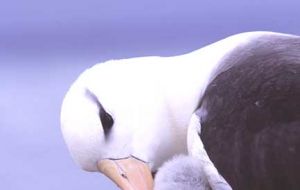MercoPress. South Atlantic News Agency
Falklands Albatross: encouraging survey results with new methodology
 Black-browed Albatross with chick on the New Island reserve (Photo © Georgina Strange)
Black-browed Albatross with chick on the New Island reserve (Photo © Georgina Strange)  Ian and Georgina Strange taking aerial survey photographs from the door of a helicopter (Photo © Dan Birch)
Ian and Georgina Strange taking aerial survey photographs from the door of a helicopter (Photo © Dan Birch) Population data has been collected for one colony on the New Island reserve for the last 29 years, and as such is the only long term data set for the Falkland Islands.
This data clearly shows that the Black-browed albatross population at this site has increased over this period by 101%. See: Black-browed albatross Thalassarche melanophris Population Census at New Island South, Falkland Islands, September – October 2004. September 2006 and Increases in Populations from 1977-2007, in a recently published book " New Island, Falkland Islands - A South Atlantic Wildlife Sanctuary for Conservation Management " July 2007. Data from some other small to medium sized sites in the vicinity of New Island have also shown increases in their populations in the last decade. To level the general criticism that such sites are not representative of larger colonies and therefore cannot be used to support the author's belief that such increases are general across all colonies in the Falkland Islands, an all-Island survey was carried out at the commencement of the 2005-2006 breeding season. One of the objectives of this survey was to obtain up to date aerial photographic images and data to make comparisons with an aerial photographic survey made in 1986. Additionally data from surveys made of selected sites in other years were brought together for comparisons to be made. The results of these surveys have been presented in two forms: tables of figures and visual. The latter uses a selection of aerial images, both monochrome and colour photographs, to illustrate the methodology, the variation in the colonies terrain and a series of comparative images from the 1986 and 2005 surveys. In some cases where it was considered necessary, images were used from surveys made in other years. For example, the results of aerial surveys of Beauchene Island, made as far back as 1964 are also used for comparison. All these support the findings of the report that the population of Black-browed albatross in the Falkland Islands has shown an increase in the last twenty years, contrary to an often publicised belief that the population in the Islands has declined and continues to do so. The survey results are taken from complete aerial photographic surveys of eight major breeding colonies including Steeple Jason Island, Beauchene Island, the two largest in the Islands, Grand Jason Island, Bird Island and North Island. From these five sites an additional thirty surveys were made of sample areas taken from the 1986 and 2005 survey images. These sampled areas were effectively re counts and methodology used to illustrate the large variability that can exist within a breeding site, percentage increases varying from 8.4% to 141%. Of particular significance and revealed through the use of these aerial images, was the finding of four small areas where there was clear evidence that a population had decreased within a colony area. One such area was found on Bird Island, where a heavily populated breeding area is clearly shown in the 1986 survey images, but has disappeared in the 2005 images, although the total island population has increased in the same period by 34.5%. A similar situation was found in two small isolated sections of the Beauchene Island population and on Elephant Jason Island, although both sites have overall increases in their populations. The percentage increases for the total populations of the sites above gave a variation of between 34.5% and 52.3%. The average for New Island over the same period was 50.6% indicating a close correlation between the long term data of this site and those elsewhere in the Islands. The lowest increase for all those sites surveyed was Elephant Jason Island with a figure of 9.7%, although the neighbouring site on South Jason Island showed a very significant increase of 323%. Removing the exceptional increase for South Jason Island, the average increase for these seven major sites, from eleven found in the Falkland Islands, is 43.8% in the period between 1986 and 2005. Surveys made of Bird Island, New Island and North Island in 2006 show this upward trend to be continuing. There may be concerns that such results could influence the huge amount of work being put into mitigation and measures to reduce the by catch of albatross by the commercial fishery, the author does not believe this to be. On the contrary, both conservationists and the fishery should welcome such news, it could be an indicator of the value of the fishery to the Falklands population of albatross, which may have been underestimated. The Falkland fishery, in the authors view, may be the reason for the species increase due to the large amount of fishery waste which it is known the birds take. Good news can be an incentive for authority and the industry to work together, not just on improved methods to reduce by catch of albatross, but on the future continuation of that fishery, for should that industry collapse then the Islands will see a huge decrease in its Black-browed albatross. By Ian J. Strange for MercoPressThe author, a resident in the Falkland Islands, is a free lance naturalist with some 46 years experience in conservation and in photographic aerial surveying of wildlife in the Islands. He presently operates the New Island reserve and facility for biological and conservation research. See: www.newislandtrust.com




Top Comments
Disclaimer & comment rulesCommenting for this story is now closed.
If you have a Facebook account, become a fan and comment on our Facebook Page!